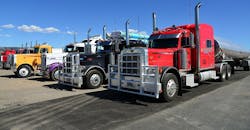NTEA addresses truck, trailer GCWR in recent technical article
The National Truck Equipment Association (NTEA) recently published the following technical article by Steve Spata, the association’s technical assistance director, addressing a truck’s gross combined weight rating (GCWR) and where to find it:
The meaning of GCWR can depend on who is asking the question. The term originated from trailer towing, where weight rating is a maximum value for the combination of a truck and trailer. It represents a vehicle’s entire weight at the ground with a trailer(s), including vehicle, equipment, driver, fuel and payload—everything that moves with the vehicle. Chassis OEMs establish GCWR as the limit the towing vehicle can handle, preserving performance without risking damage.
Numerous factors and considerations are involved in developing a GCWR, and standardized methods are defined in SAE J2807 for pickups and other light vehicles. However, there are several chassis components that are primary contributors to GCWR: engine, transmission and drive-axle ratio.
Generally, a higher axle ratio will enable a higher GCWR for the same chassis model/powertrain. Note, maximum trailer weight will typically accompany these specifications because the amount of weight that can be attributed to the trailer is limited—even if the combined weight of the loaded truck and trailer does not exceed GCWR. However, towing equipment ratings and other considerations must be evaluated, as they may be more limiting than GCWR and maximum trailer weight for a specific configuration.
GCWR is also a criterion used by Federal Motor Carrier Safety Administration (FMCSA) in determining if a commercial driver’s license (CDL) is required for the combination being operated.
FMCSA defines GCWR as “the greater of:
A value specified by the manufacturer of the power unit, if such value is displayed on the Federal Motor Vehicle Safety Standard (FMVSS) certification label required by the National Highway Traffic Safety Administration, or
The sum of the gross vehicle weight ratings (GVWRs) or the gross vehicle weights (GVWs) of the power unit and the towed unit(s), or any combination thereof, that produces the highest value. Exception: The GCWR of the power unit will not be used to define a commercial motor vehicle when the power unit is not towing another vehicle.”
National Highway Traffic Safety Administration does not require GCWR on vehicle certification labels, so unless a manufacturer includes the value as extra information, motor carrier enforcement would likely use the sum of the GVWRs as GCWR during a roadside inspection. If GCWR is 26,001 pounds or more, and the trailer being towed has a GVWR of 10,001 pounds or more, the combination would be considered a commercial motor vehicle for CDL purposes (see CFR 49 Part 383, Commercial Driver’s License Standards; Requirements and Penalties for more details).
Another industry use of GCWR is for Federal Excise Tax (FET) as it applies to tractors. For vehicles Internal Revenue Service (IRS) would classify as tractors, there is a two-part test describing one to which the tax would not apply: (1) a GVW of 19,500 pounds or less and (2) a GCW, in combination with a trailer or semitrailer, of 33,000 pounds or less. Additional factors on the definition of a tractor apply, but GCWR is important for IRS in determining potential FET taxability.
Stated weight factors in the test do not specify the rating in the respective limits, but since actual gross vehicle and gross combined weights, which vary with vehicle loading, should not exceed either of these ratings, GVWR and GCWR would serve as practical limits. IRS typically will accept the chassis manufacturer’s rating when determining taxability.
Each of these GCWR applications traces back to manufacturer ratings, so OEM towing charts are a convenient source. These are typically found on respective OEM body builder sites, which are accessible by logging in to ntea.com/oemdirectory.
Build configuration sheets detailing components/features/specifications of a given chassis are another source for GCWR values. Truck dealers should have access to these records, as well as OEM applications engineering teams.


